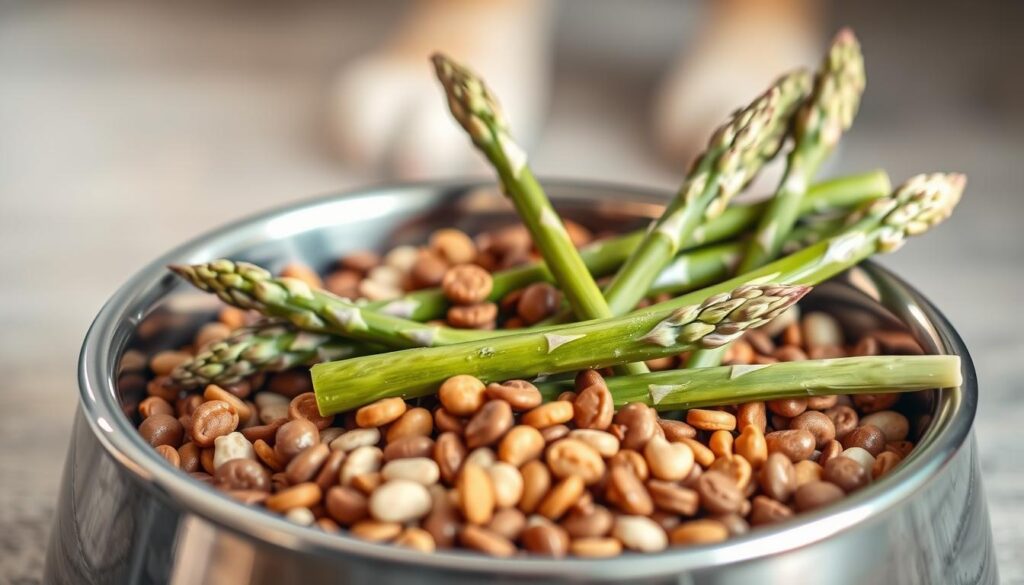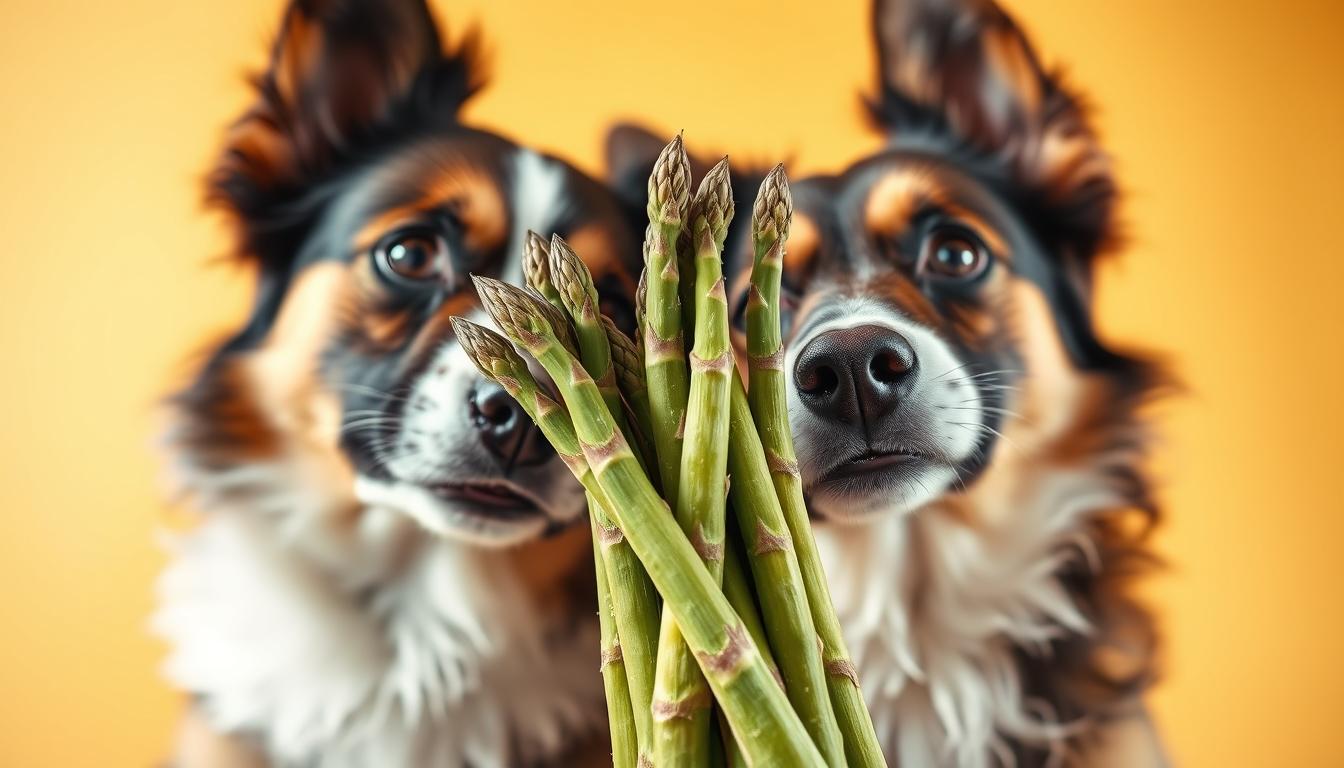Why Do Dogs Eat Asparagus? Nutrition Facts & Safety
Ever caught your furry friend eyeing that green spear on your plate with curiosity? As a dog owner, you might wonder about the surprising fascination your canine companion has with asparagus. Dogs eat asparagus more often than you might expect, and understanding their diet can reveal interesting insights into canine nutrition.
Our pets are more than just companions – they’re family members with unique dietary preferences. Dogs have an innate curiosity that can sometimes surprise us. Asparagus might seem like an unlikely treat, but many dogs find it intriguing and potentially nutritious.
Understanding what makes asparagus appealing to dogs requires a closer look at their dietary needs and natural instincts. While not a staple in canine nutrition, this vegetable can offer some unexpected benefits when introduced carefully and in moderation.
Table of Contents
Key Takeaways
- Dogs can safely consume asparagus in small quantities
- Asparagus offers potential nutritional benefits for dogs
- Proper preparation is crucial for safe consumption
- Not all dogs will enjoy or tolerate asparagus equally
- Consult with a veterinarian before significant dietary changes
Understanding Your Dog’s Interest in Asparagus
Dogs are curious and love to eat, just like their wild ancestors. They might show interest in veggies like asparagus. This is because of their instincts and love for trying new foods.
Dogs are drawn to green veggies because of their wild roots. They have instincts from their wolf ancestors, who ate plants to add to their diet.
Natural Foraging Instincts in Dogs
Your dog’s love for asparagus comes from their wild side. Dogs are not just meat-eaters; they can also eat plants. Their ancestors ate plants to get more nutrients and to help with digestion.
- Obtain additional nutrients
- Aid digestive processes
- Satisfy nutritional curiosity
Why Dogs Are Attracted to Green Vegetables
Green veggies like asparagus are fun for dogs to eat. They like the crunchy feel and smell. Some dogs might be attracted to the rustling sound and movement of green vegetables, which makes them want to hunt and forage.
“Dogs are natural explorers, and their diet can be more diverse than we often assume.” – Veterinary Nutrition Expert
Not all dogs will love veggies as much, but knowing their curiosity can help. It can guide you in adding veggies to their meals.
Nutritional Benefits of Asparagus for Dogs
Asparagus is a great addition to your dog’s food. It’s full of nutrients that help keep your dog healthy. This green veggie is packed with vitamins and minerals that support your dog’s well-being.
Asparagus does more than just provide nutrients. It’s rich in vitamins and minerals that offer several health benefits:
- Vitamin K for blood clotting and bone metabolism
- Vitamin C to boost immune system function
- Folate for cellular growth and development
- Potassium for muscle and nerve health
Asparagus can be a big help for your dog’s nutrition. It’s high in fiber, which is good for digestion. It’s also low in calories, making it a great choice for dogs watching their weight.
| Nutrient | Amount per 100g | Benefit for Dogs |
|---|---|---|
| Fiber | 2.1g | Improves digestive health |
| Vitamin K | 41.6 mcg | Supports bone metabolism |
| Potassium | 202 mg | Maintains muscle function |
If you want to add variety to your dog’s diet, asparagus is a good choice. Always introduce new foods slowly and talk to your vet before adding them to your dog’s diet.
Can Dogs Eat Asparagus Safely?
Feeding asparagus to dogs needs careful thought. Dogs react differently to asparagus, so it’s important to know how to feed it right.
To safely add asparagus to your dog’s diet, focus on preparation and moderation. Raw asparagus can be hard for dogs to digest and might be risky.
Raw vs. Cooked Asparagus
Cooked asparagus is safer and easier for dogs to digest. Raw asparagus has its own set of challenges:
- Tough, fibrous texture difficult to chew
- Potential digestive strain
- Risk of intestinal discomfort
Potential Choking Hazards
Asparagus spears can be a choking hazard for dogs. To avoid this, follow these tips:
- Cut asparagus into small, bite-sized pieces
- Remove tough, woody ends
- Steam or boil to soften the vegetable
Safe Serving Sizes
It’s important to control the amount of asparagus you give your dog. Moderation is key. Here’s a general guide:
- Small dogs: 1-2 small pieces
- Medium dogs: 2-3 pieces
- Large dogs: 3-4 pieces
Always consult with your veterinarian before making significant changes to your dog’s diet.
How Dogs Eat Asparagus: Best Practices
Adding asparagus to your dog’s diet needs careful thought and smart tips. First, prepare the vegetable safely and in a way your dog will like.
Asparagus can be a great addition to your dog’s diet. Here are some tips for serving it to your furry friend:
- Steam the asparagus to make it easier to digest
- Cut into small pieces to avoid choking
- Give it in small amounts as an occasional treat
- Remove the tough ends before serving
Pro tip: Always introduce new foods slowly to watch how your dog reacts.
“Slow and steady wins the race when adding new foods to your dog’s diet.” – Veterinary Nutrition Experts
For dogs trying asparagus for the first time, start with a tiny amount. Look for any signs of upset stomach or allergies. Some dogs might not like the taste or texture, so don’t push it if they don’t want it.
Here are some creative ways to serve asparagus:
- Mix chopped asparagus with their regular food
- Puree it and add to homemade dog treats
- Use it as a low-calorie reward for training
Remember, every dog is different. What works for one might not work for another when trying new foods.
Potential Risks and Side Effects
Asparagus can be good for your dog, but it’s important to know the risks. Not every dog will react the same way. It’s key to watch how your dog does to keep them healthy.
When adding new foods to your dog’s diet, watch closely. Some dogs might have trouble digesting asparagus.
Digestive Challenges to Monitor
- Mild stomach upset
- Unexpected gas production
- Soft or loose stools
- Potential bloating
Recognizing Asparagus Intolerance
Your dog might show signs they can’t handle asparagus. Knowing these signs can help avoid health problems.
| Intolerance Symptom | Potential Severity | Recommended Action |
|---|---|---|
| Persistent vomiting | High | Stop feeding immediately |
| Excessive flatulence | Low | Reduce portion size |
| Abdominal discomfort | Medium | Consult veterinarian |
Start with small quantities of asparagus in your dog’s diet. Look for any odd reactions. If problems keep happening, stop giving it to them.
Incorporating Asparagus into Your Dog’s Diet

Adding asparagus to your dog’s diet needs careful planning. It’s good for them, but it should not be the only food they eat. It should be part of a balanced diet.
Start with small amounts of asparagus to help your dog digest it well. Here are some tips to help you:
- Begin with tiny, bite-sized pieces
- Cook asparagus thoroughly to improve digestibility
- Remove tough stems that might cause choking
- Limit asparagus to 10% of your dog’s total meal volume
Every dog is different. Talking to a vet can help figure out how much asparagus is right for your dog. Some dogs might not like it as much as others.
Keep an eye on how your dog reacts to asparagus. Look for signs of upset stomach or allergies. Adding it slowly helps keep your dog safe and healthy.
“Variety in a dog’s diet can promote overall wellness when introduced thoughtfully.” – Veterinary Nutrition Experts
Asparagus should be a special treat, not a main food. Your dog’s main diet should be high-quality, balanced food.
Alternative Vegetables for Your Canine Companion
Adding new veggies to your dog’s diet can be great. It brings in important nutrients and variety. Vegetables are good for dogs when given the right way.
Dogs love eating veggies as a treat. They help keep your pet healthy and happy. The right veggies add vitamins and minerals.
Safe Vegetable Options
- Carrots: Low-calorie, high-fiber vegetable packed with beta-carotene
- Green Beans: Excellent source of vitamins K and C
- Pumpkin: Supports digestive health and provides essential nutrients
- Sweet Potatoes: Rich in vitamin A and dietary fiber
- Spinach: Contains iron and antioxidants
Preparation Methods
It’s important to prepare veggies right for dogs. Cut them into small pieces to avoid choking. This makes them safe and easy to eat.
| Vegetable | Preparation Method | Serving Size |
|---|---|---|
| Carrots | Raw or steamed | Small pieces, 1-2 per serving |
| Green Beans | Steamed or blanched | Chopped, 2-3 tablespoons |
| Pumpkin | Cooked, plain | 1-2 tablespoons |
Always talk to your vet before changing your dog’s diet. This ensures they stay healthy and well-nourished.
“Variety in diet can help maintain your dog’s interest and provide essential nutrients” – Veterinary Nutrition Experts
When to Avoid Feeding Asparagus to Dogs

When adding new foods like asparagus to your dog’s diet, be careful. Asparagus can be good for them, but there are times when you should be cautious.
Here are some situations where you should not give asparagus to your dog:
- Dogs with sensitive digestive systems
- Canines experiencing gastrointestinal issues
- Pets on specific medication regimens
- Dogs with kidney problems
Vets say it’s important to pay extra attention to certain dogs. Puppies and older dogs might need special care because of their diet.
| Dog Category | Asparagus Recommendation |
|---|---|
| Puppies | Avoid or minimal consumption |
| Senior Dogs | Consult veterinarian first |
| Dogs with Health Conditions | Strictly limit or eliminate |
Always think about what’s best for your dog’s health. Getting advice from a vet is key before changing their diet.
“Your dog’s unique health profile determines dietary choices” – Veterinary Nutrition Experts
If your dog acts strangely after eating asparagus, stop giving it to them. Then, talk to your vet for advice that fits your dog’s needs.
Conclusion
Looking into whether dogs eat asparagus shows it’s more than just a simple question. Each dog has its own needs, making it important to think carefully before adding new foods. Knowing the good and bad points helps you decide what’s best for your pet.
Getting advice from a vet is key when trying new foods for your dog. Asparagus might be good for them, but it should not be the only thing they eat. Start with small amounts and watch how your dog reacts.
Being a good pet owner means paying close attention to your dog’s health. Watch how they do with asparagus and talk to a vet for advice. Good dog food is about finding the right mix for your pet.
Every dog is unique, so what’s good for one might not be for another. Focus on your dog’s health first. If they do well with asparagus, it can be a good addition to their diet.







